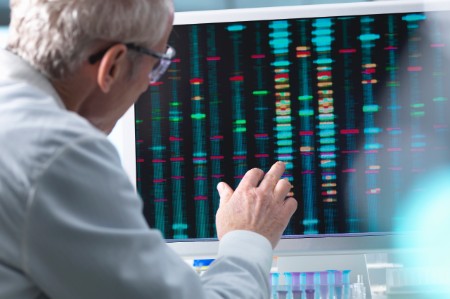
The better the question
How can CGT treatments go from ambition to reality?
The World Health Organization (WHO) predicts that by 2040, new cancer cases per year will exceed 27 million – a 50% increase from 2018.
The anticipated rise in cancer cases can be attributed to people living longer; growing exposure to risk factors, especially in low- and middle-income countries; and an expected increased incidence among younger people.
While we haven’t yet won the war on cancer, we are winning some battles. Over the past 30-plus years, survival rates have doubled, and people are living longer with cancer than ever before. Novel treatments are helping patients delay the worsening of their disease or lower the chance of recurrence, while improving their overall quality of life.
On the scientific front, we are witnessing what experts are calling a “golden age” of cancer research and discovery. We know that cancer is not one, but many diseases – more than 200 in fact. And our knowledge and management of those diseases is increasing at a rapid pace.
Some of the most exciting, life-changing possibilities for patients with cancer and other serious illnesses are in cell and gene therapies (CGT). Cell therapy aims to treat disease by restoring or altering certain sets of cells or by using cells to carry a therapy through the body. Gene therapy replaces, inactivates or introduces genes into cells. Therapies that are considered both cell and gene therapies alter genes in specific types of cells and insert them into the body.
In addition to being difficult to create and administer, cell and gene therapies are also very expensive and only available to a handful of people. EY examined how it could help transform the treatment of oncology and other serious diseases by enabling highly effective and efficient delivery of individualized therapies at commercial scale.
The EY team leveraged its strengths with data, technology and trust to develop a fully connected data infrastructure — Pointellis™ — with associated capabilities and services. This digital backbone expedites a flow of information along the end-to-end value chain, helping patients to receive the care they need while revolutionizing patient outcomes.
This data infrastructure will speed up the delivery of these life-saving therapies, minimize costly errors, avoid duplicative systems costs and make them available to everyone who can benefit from them.
Health outcomes that were once unimaginable are now within reach.
“Individualized therapies can dramatically improve outcomes in cancer and alleviate the burden of these catastrophic diseases,” says Pamela Spence, EY Global Health Sciences and Wellness Industry Leader. “This is not just a game changer for cancer care but has the potential for application in a number of other very debilitating diseases.”
Gene therapy has been a work in progress for almost 40 years, but it is now experiencing an acceleration. In 2017, the U.S. Food and Drug Administration (FDA) approved the first gene therapy treatments. While 2019 only saw one approval, the agency expects to see a doubling of new gene therapy applications every year. Scott Gottlieb, the former FDA Commissioner, predicted that by the year 2025, the US will be approving between 10 and 20 different gene therapies every year.
However, the evolving cancer treatment paradigm from a mass market (1-for-Many) to an individualized (N of 1) poses significant challenges that will multiply as CGT options and their usage increase.
“These treatments use the patient’s own blood or tissue, which is transformed into a personalized therapy and then reinfused. There is no room for error – the system must deliver the right drug for the right patient at the right time and right place, every time,” says Adlai Goldberg, EY Global Digital, Social and Commercial Innovation Life Sciences Leader.
The operational requirements for individualized care
The only way to make cell and gene therapies a reality at scale is to create an ecosystem of different stakeholders working together and sharing data and information they all trust. This includes patients, health care providers, health services companies, insurers, payers, and the biopharmaceutical industry. No single player – regardless of how smart or well-funded – can do this alone.
Truly individualized care requires an error-free outcome from beginning to end. It means creating a value chain with far better transparency and a real-time understanding of what's going on with every individual patient throughout the course of their therapy at any point in time. How did EY approach this challenge? By asking the right questions.

The better the answer
Connecting the CGT ecosystem with an open, trusted data exchange
Reimagining biopharma processes and supply chains to help provide the right CGT treatment to the right patient, at the right time and place.
EY approach
A cross-functional, multidisciplinary EY team that included EY wavespace™, an EY growth and innovation center connecting people, solutions and technology to tackle complex challenges, studied each step and connectivity along the CGT value chain. It asked: what issues could arise? What changes are required to address them? The team leveraged EY’s multidisciplinary capabilities and diverse geographies and experiences to further define and solve this complex problem.
Identifying challenges at every step of the CGT process – for example:
- Genetic sampling and sequencing: core to an individualized treatment may be the collection of a patient’s blood and tumor biopsy, analysis of their genetic makeup, identification of genetic mutations in the tumor and development of a therapy that targets those genetic mutations. How does the industry conduct genetic sequencing at the required level of specificity and commercial scale to serve a global market?
The question was: how do we create an environment where that could exist?
- Transportation logistics: Moving not just patient samples but very large amounts of patient data securely is a central challenge to implementing individualized therapies. For instance, crossing national borders means crossing different jurisdictions, which may have different regulations pertaining to the movement of data, tissue and therapeutic products.
The question was: how do we allow end-to-end operations to exist across different legal entities and regulatory guidelines?
- Administration of therapies: Traditionally, the same cancer drugs were administered to thousands of people, with treatments being manufactured and then distributed to the medical centers for mass distribution. But when treatments are created for a specific individual, the timely flow of information becomes far more complex with the involvement of many more stakeholders.
The question was: how can health systems and oncologists handle receiving, storing and administering individualized therapies for every patient?
- Care management: As life expectancy after cancer diagnosis and treatment continues to improve, there is growing recognition of the need to address patients’ health and wellness, emotional and psychosocial needs from the time of diagnosis through treatment and survivorship.
The question was: how can we leverage the large body of patient data to create an end-to-end care management system that engages and empowers patients and improves their overall health and quality of life?
The EY team also conducted market research of more than 450 professionals (practicing oncologists, oncology thought leaders, health care providers, payers and other stakeholders) across multiple geographies (the US, France, Germany and Spain), to better understand the current care management paradigm and determine needed behavioral and process change from patient, health care, manufacturing, intermediary and reimbursement standpoints.
Building a fully connected infrastructure of data, capabilities and services with Microsoft
Working with Microsoft, EY LLP developed a private, secure broad services information platform to help enable the reliable delivery of individualized therapies for cancer and other chronic diseases.
We call it Pointellis™.
Pointellis™ introduces new industry data capabilities focused on enabling six core functional areas of the digital ecosphere:
- Biometric chain of identity and custody, to track and trace biopsy tissue and blood samples from point of care when the patient first enters the system, all the way through medicine administration;
- Supply chain, to allow for enrolment, scheduling, demand and capacity planning as well as coordination of logistics and delivery;
- Patient engagement, to share appropriate information and keep the patient engaged through the waiting process as well as provide disease management information;
- Care management, to provide oncologists and health care providers who treat and support these critically ill patients with up-to-date information and decision support based on the wealth of data captured through the platform;
- Health outcomes, to measure more accurately and allow providers, health systems, payers and manufacturers to adapt treatment and maximize clinical benefit; and,
- Funds allotment, to manage the complexities of paying all who are involved with the successful treatment of a patient.
“Combining EY and Microsoft’s experience was fundamental to developing Pointellis™, which connects the many stakeholders involved in providing individualized treatments,” says Goldberg, “Pointellis™ enables a supply chain as individual as the treatment itself, one for each patient. It safeguards the chain of custody and identity, validating every handoff from patient through to manufacturer and back again.”

The better the world works
A game changer for cancer treatment … and for chronic diseases
The new information exchange expedites a flow of information along the end-to-end value chain, helping patients receive the care they need.
EY teams are working with organizations across health, life sciences and other sectors to make cell and gene therapies available at scale. We’re helping them understand the role they play in this new era of health care and what it takes to get there. We’re using our expertise in business model design, information flow and data analytics to help them develop and shape the ecosystems that CGT requires. And we’re continuing to build the information platform needed to make these ecosystems work for patients: Pointellis™.
Our hope is that by providing this trusted platform, we’re liberating everyone else in the ecosystem to focus on what they do best – from developing new science, to delivering outstanding logistics, to keeping patients and their health providers connected and engaged.
“Data and technology can help deliver personalized, life-altering therapies at scale and with security, accessibility and reliability,” said David Rhew, M.D. Microsoft Chief Medical Officer and Vice President of Healthcare, Worldwide Commercial Business (WCB). “We are working to solve the challenge of seamlessly ingesting and enriching any volume, variety or velocity of health care data from one system to another to ensure that patients receive the right treatment, at the right place, at the right time.”
Leaders who embrace this potential now and actively come together won’t just change the lives of people with cancer and other serious diseases. They will put their organizations at the forefront of next generation health.
By providing a digital backbone, Pointellis™ is facilitating the transformation of the cell and gene therapy industry and allowing stakeholders to collaborate in unprecedented ways. These connections will promote the continued growth and success of the industry as it moves to greater level of commercialization, with the EY organization playing a central role.
Please visit PointellisTM to learn more.


